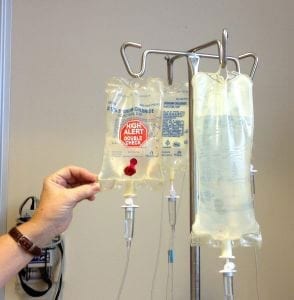According to BioSpace, Kronos Bio will continue with its plans for a Phase 3 trial of entospletinib after a positive meeting with the FDA. One of the meeting’s focuses was the primary endpoint of the upcoming trial, which they determined will be an assessment of measurable residual disease (MRD) negative complete response (CR). They will use this endpoint to evaluate entospletinib, a treatment for newly diagnosed NPM1-mutated acute myeloid leukemia (AML).
About the Meeting
Kronos met with the FDA after the completion of its Phase 2 trial of entospletinib, which demonstrated results that supported a Phase 3 study. One of the most important things determined at this meeting was the primary endpoint for this future study; the FDA supported Kronos’ plan to use an assessment of measurable residual disease (MRD) negative complete response (CR).
MRD describes the low amount of cancer cells that remain during or after treatment, even after a patient has achieved a complete response. When a patient is MRD negative, they often experience longer remission and higher survival rates. There is also a much lower chance of relapse.
This primary endpoint has never before been used in an AML trial. Leading experts have promoted the usefulness of using MRD negativity as an endpoint, as it is associated with better outcomes for patients.
About the Study
This study will be randomized, placebo-controlled, double-blind, and enroll 180 adult participants in order to assess the safety and efficacy of entospletinib. In addition to standard treatment of induction and consolidation chemotherapy, patients will receive either a placebo or entospletinib for at least two cycles.
In addition to the primary endpoint, the secondary endpoint will be event-free survival. Data based on this endpoint will be used to support FDA approval later on.
About AML
Acute myeloid leukemia is a blood and bone marrow cancer, characterized by abnormal red blood cells, myeloblasts, or platelets made by the bone marrow. These abnormal cells accumulate until they crowd out healthy cells. This results in symptoms like bone pain, fever, easy bruising, shortness of breath, frequent infections, pale skin, fatigue, unusual bleeding, and lethargy. Medical professionals are aware that mutations in the DNA of the bone marrow lead to this cancer; however, they are unsure as to the cause of these mutations. They do know that exposure to certain chemicals, radiation, and some chemotherapy drugs can heighten one’s risk of developing AML. In terms of treatment, doctors will make a plan based on a patient’s overall health, disease subtype, and preference. Often, they will use remission induction therapy followed by consolidation therapy. Other options include chemotherapy, a stem cell transplant, or other drug therapies.








